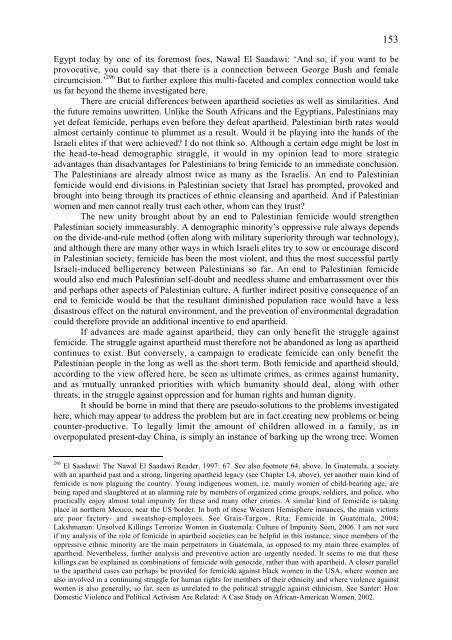Apartheid
Apartheid
Apartheid
You also want an ePaper? Increase the reach of your titles
YUMPU automatically turns print PDFs into web optimized ePapers that Google loves.
153<br />
Egypt today by one of its foremost foes, Nawal El Saadawi: ‘And so, if you want to be<br />
provocative, you could say that there is a connection between George Bush and female<br />
circumcision.’ 296 But to further explore this multi-faceted and complex connection would take<br />
us far beyond the theme investigated here.<br />
There are crucial differences between apartheid societies as well as similarities. And<br />
the future remains unwritten. Unlike the South Africans and the Egyptians, Palestinians may<br />
yet defeat femicide, perhaps even before they defeat apartheid. Palestinian birth rates would<br />
almost certainly continue to plummet as a result. Would it be playing into the hands of the<br />
Israeli elites if that were achieved? I do not think so. Although a certain edge might be lost in<br />
the head-to-head demographic struggle, it would in my opinion lead to more strategic<br />
advantages than disadvantages for Palestinians to bring femicide to an immediate conclusion.<br />
The Palestinians are already almost twice as many as the Israelis. An end to Palestinian<br />
femicide would end divisions in Palestinian society that Israel has prompted, provoked and<br />
brought into being through its practices of ethnic cleansing and apartheid. And if Palestinian<br />
women and men cannot really trust each other, whom can they trust?<br />
The new unity brought about by an end to Palestinian femicide would strengthen<br />
Palestinian society immeasurably. A demographic minority’s oppressive rule always depends<br />
on the divide-and-rule method (often along with military superiority through war technology),<br />
and although there are many other ways in which Israeli elites try to sow or encourage discord<br />
in Palestinian society, femicide has been the most violent, and thus the most successful partly<br />
Israeli-induced belligerency between Palestinians so far. An end to Palestinian femicide<br />
would also end much Palestinian self-doubt and needless shame and embarrassment over this<br />
and perhaps other aspects of Palestinian culture. A further indirect positive consequence of an<br />
end to femicide would be that the resultant diminished population race would have a less<br />
disastrous effect on the natural environment, and the prevention of environmental degradation<br />
could therefore provide an additional incentive to end apartheid.<br />
If advances are made against apartheid, they can only benefit the struggle against<br />
femicide. The struggle against apartheid must therefore not be abandoned as long as apartheid<br />
continues to exist. But conversely, a campaign to eradicate femicide can only benefit the<br />
Palestinian people in the long as well as the short term. Both femicide and apartheid should,<br />
according to the view offered here, be seen as ultimate crimes, as crimes against humanity,<br />
and as mutually unranked priorities with which humanity should deal, along with other<br />
threats, in the struggle against oppression and for human rights and human dignity.<br />
It should be borne in mind that there are pseudo-solutions to the problems investigated<br />
here, which may appear to address the problem but are in fact creating new problems or being<br />
counter-productive. To legally limit the amount of children allowed in a family, as in<br />
overpopulated present-day China, is simply an instance of barking up the wrong tree. Women<br />
296 El Saadawi: The Nawal El Saadawi Reader, 1997: 67. See also footnote 64, above. In Guatemala, a society<br />
with an apartheid past and a strong, lingering apartheid legacy (see Chapter I.4, above), yet another main kind of<br />
femicide is now plaguing the country. Young indigenous women, i.e. mainly women of child-bearing age, are<br />
being raped and slaughtered at an alarming rate by members of organized crime groups, soldiers, and police, who<br />
practically enjoy almost total impunity for these and many other crimes. A similar kind of femicide is taking<br />
place in northern Mexico, near the US border. In both of these Western Hemisphere instances, the main victims<br />
are poor factory- and sweatshop-employees. See Grais-Targow, Rita: Femicide in Guatemala, 2004;<br />
Lakshmanan: Unsolved Killings Terrorize Women in Guatemala: Culture of Impunity Seen, 2006. I am not sure<br />
if my analysis of the role of femicide in apartheid societies can be helpful in this instance, since members of the<br />
oppressive ethnic minority are the main perpetrators in Guatemala, as opposed to my main three examples of<br />
apartheid. Nevertheless, further analysis and preventive action are urgently needed. It seems to me that these<br />
killings can be explained as combinations of femicide with genocide, rather than with apartheid. A closer parallel<br />
to the apartheid cases can perhaps be provided for femicide against black women in the USA, where women are<br />
also involved in a continuing struggle for human rights for members of their ethnicity and where violence against<br />
women is also generally, so far, seen as unrelated to the political struggle against ethnicism. See Santer: How<br />
Domestic Violence and Political Activism Are Related: A Case Study on African-American Women, 2002.

















